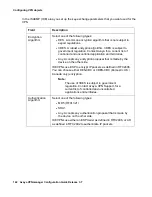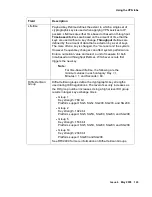
Issue 4 May 2005
133
Chapter 7: Configuring VPN objects
A VPN object is the method used for linking security gateways, remote terminals, and LAN
terminals in a fully configured virtual private network. To create a VPN, you name the VPN,
select a key management method, and optionally, designate it as the Default VPN. After that
you can configure the VPN using VPNmanager, using the tabs associated with the created
VPN. When you configure the VPN, you add users and user groups and further define the IKE,
IPSec, and SKIP security protocols for VPN traffic.
Types of VPN objects
Two types of VPN objects can be built.
●
SKIP based VPN
●
IKE based VPN
Both types use IP Security Protocol (IPSec) for encrypting and decrypting VPN traffic. The main
difference between the two VPN types are the methods used for creating the encryption key.
When you create a VPN object, you select which protocol to use.
SKIP VPNs
Note:
Note:
SKIP VPNs are supported in VPNremote Client 2.5 only.
Simple Key-management for IP (SKIP) is a protocol that stores authentication and security
information in every packet. SKIP VPNs can operate in Tunnel or Transport modes. Tunnel
mode involves encrypting the entire original IP packet before it goes out to the public networks.
Transport mode involves encrypting only the payload of the original packet. Also, SKIP VPNs
can be manually rekeyed at any time.
Summary of Contents for 3.7
Page 1: ...VPNmanager Configuration Guide Release 3 7 670 100 600 Issue 4 May 2005...
Page 4: ......
Page 20: ...Preface 20 Avaya VPNmanager Configuration Guide Release 3 7...
Page 32: ...Overview of implementation 32 Avaya VPNmanager Configuration Guide Release 3 7...
Page 53: ...Preferences Issue 4 May 2005 53 Figure 16 Tunnel End Point Policy...
Page 54: ...Using VPNmanager 54 Avaya VPNmanager Configuration Guide Release 3 7...
Page 244: ...Using advanced features 244 Avaya VPNmanager Configuration Guide Release 3 7...
Page 292: ...Upgrading firmware and licenses 292 Avaya VPNmanager Configuration Guide Release 3 7...
















































